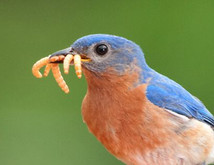How to Use Mealworms to Attract Bluebirds to Your Home
Many of us have wondered, while watching those beautiful bluebirds seen fluttering around the trees, if it were possible to somehow bring them closer to fully appreciate their intriguing and majestic nature. Maybe some of us have even seen the spark of wonder in our children’s eyes as they watch them soar around, making us want to give our little ones an opportunity to learn more about them! One proven way to give bluebirds a reason to stick around is to offer them a food source in the form of mealworms.
Because of the deforestation and pesticide spraying happening in recent years, many of the grubs that are part of a bluebird’s diet have disappeared. Bluebirds need grubs for protein, which is a hard thing to come by in the wild. During the spring, the birds go through a molting process and need to generate new feathers, a process which requires using protein stores! Mealworms are such a good grub to offer bluebirds because they are high in protein, made up of around 20-48% (Zimmerman, 2013). Additionally, if you have a nesting couple, your mealworm offering will save the female from having to leave her incubating eggs for a long period of time. Mealworms also help bluebirds survive during long spells of severe winter weather by providing them with essential protein, fat, and carbohydrates.
An article that appeared in Backyard Bird Newsletter, August, 2005 written by Diane Porter told the author’s story of how she attracted bluebirds to her nesting box by offering them mealworms, and how they built a nest within three days after she initially fed them. Diane ordered some mealworms in hopes of having bluebirds move into her birdhouse where she could watch them from her kitchen window. When they arrived, she excitedly placed a few mealworms on her feeder outside while whistling the bluebirds’ song. Within one hour of placing the mealworms out on her nesting box, two bluebirds came to gobble them up! Diane even used a technique which many others have become successful at, and trained her bluebirds to come whenever she imitated their call. She writes “they didn’t come around when I was headed for my car or a walk, but if I stepped out of the house whistling, with mealworms in my hand, the two birds flew toward the birdhouse from wherever they were in the woods” (Porter, 2005). Soon after, babies were born in her nest box! The author states that she feels immense satisfaction after being able to communicate with these wild beautiful birds, and she feels she bridged a gap between her happiness and theirs.
If you’re wondering how to feed mealworms to bluebirds, there are several options. Several different feeders are available, although they can also be scattered on the ground. The latter is discouraged, however, because mealworms are a delicious treat for all types of birds.Your bluebirds may not get their fill of worms before they’re all gone! A hopper style feeder is most recommended, because it’s 1 ½ inch entrances excludes larger birds from stealing your birds worms. Smaller birds may enter, but an aggressive male bluebird is likely to defend “his” feeder, especially if he and his mate are nesting nearby.
Mealworms are convenient because they can be stored in the refrigerator for several months when not in use. This allows for them to be bought in bulk at a cheaper price and to be used all season long with no fear of running out and subsequently losing the newly earned bluebirds’ company. When ordering mealworms in bulk from Rainbow Mealworms, the price per thousand drops significantly. For example, 1000 mealworms is normally $6.99. When you order 10,000 mealworms, the price per thousand is only $3.70 saving you $32.90!
Although the quest is challenging, it is very rewarding to attract and keep bluebirds in your yard. Bluebirds, once having nested in your yard once, may very likely come back for generations after. Parents may pass on information to their young about where to find food sources, and this information could be about you and your generosity!

